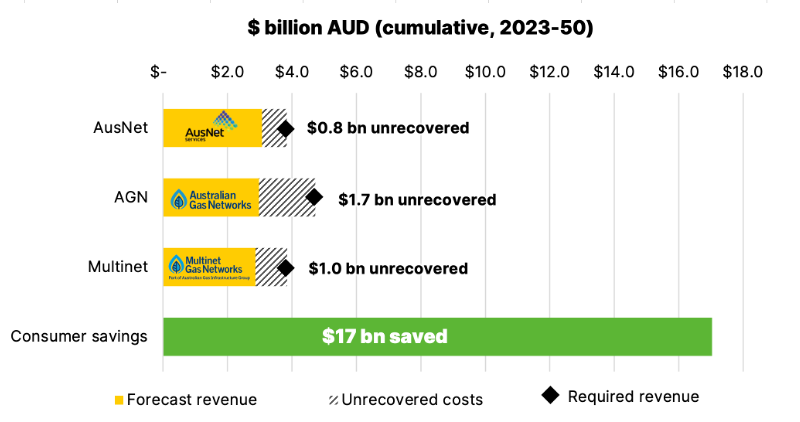Addressing Victoria’s fossil gas dilemma means ending sales of gas appliances

Electrification may leave gas distribution networks with high unrecovered costs, but the benefits to consumers are much greater.
Key Takeaways:
Switching gas appliances to efficient electric alternatives at end of life from 2025 is crucial to addressing Victoria's urgent gas supply shortfalls and emissions targets.
Gas distribution networks may face billions in unrecovered costs, but these are outweighed by the savings to consumers, and a plan is needed to wind the networks down.
Any delays increase the difficulty of the task, jeopardising emissions targets, and locking in hundreds of millions in costs for consumers.
State and federal governments must act to smooth the electrification transition by implementing standards and market arrangements for energy efficiency and demand-response capabilities, and building strong workforces and supply chains.
2 November 2023 (IEEFA Australia): Transitioning residential gas appliances to electric at end of life from 2025 will be crucial for Victoria to meet emissions reduction targets, avoid gas supply shortfalls and protect consumers from asset stranding, according to a new report from the Institute for Energy Economics and Financial Analysis (IEEFA).
Victoria accounts for 63% of Australia’s total household gas consumption due to its long reliance on cheap Bass Strait gas for heating. Those reserves are rapidly running out, and in four years the state might not have enough gas.
However, the state with the greatest appetite for gas also has the most to gain from switching to all-electric homes, according to the report by Jay Gordon, Research Analyst – Australian Electricity at IEEFA.
“There is a strong case for ending sales of gas appliances as early as 2025,” Mr Gordon says. “Victoria’s long-term gas supply shortfalls could be delayed and significantly reduced, while bringing the state’s residential emission on track towards its targets.
“Furthermore, consumers would benefit from the transition. If gas appliances were required to be replaced with efficient electric alternatives at their end of life, the average Victorian home could save $1,200 a year on their energy bills. Our analysis shows significant benefits can be achieved without the need to replace gas appliances before their end of life. However, given the financial savings on offer, many consumers may choose to do this too.”
IEEFA’s modelling shows Victorians can save $912 million overall in locked-in appliance and running costs for each year that appliances were converted to electric at end of life rather than installing a new gas appliance.
Any delay risks leaving consumers with stranded gas appliance assets, Victoria with a greater gas supply shortfall, and jeopardises Victoria’s ambitious greenhouse gas emissions targets.
“Alternative approaches, such as increasing onshore gas supply, face longer lead times, higher uncertainties, poorer outcomes for energy bills, and would be incompatible with emissions targets,” Mr Gordon says.
The transition to electrification needs to be managed to ensure that Victoria maximises the economic benefits for consumers and the energy system, and that the gas distribution networks are wound down in an efficient and fair manner.
“A plan is needed to wind down gas distribution networks,” says Mr Gordon. “If networks continue to fully recover their costs from residential customers, those customers could face unprecedented price rises.
“This could trigger a ‘gas death spiral’, where users leave the network in an uncontrolled and unpredictable fashion, leaving costs to be disproportionately borne by those who are not able to easily electrify – typically renters and low-income households.”
“If the regulator were to cap price rises even at an unprecedented 2.5% p.a. to 2050, gas distribution networks will face unrecovered costs totalling $3.5 billion as end of life gas appliances are electrified. This does not look great for the networks. But the benefit that consumers will gain from switching to electric appliances over the same period is significantly greater – approximately $17 billion in savings.
“This indicates that while electrification of end-of-life gas appliances challenges the gas distribution network business model, it is an attractive solution for decision makers due to the huge scale of consumer benefits on offer.”
Unrecovered gas distribution network costs vs consumer savings

Source: IEEFA analysis of network costs and appliance upfront and running costs if a 2.5% annual cap is applied to gas price increases from 2028.
Victoria has a narrow window to avoid forecast annual gas supply shortages by 2027. Ensuring residential electrification keeps pace by electrifying gas appliances at end of life will help reduce the gas supply gap, as well as keeping Victoria aligned to its emissions reduction targets.
“The costs of delaying the transition to electrification are significant, as the locked-in costs and stranding risks compound for every year Victorians continue to invest in gas appliances,” Mr Gordon says. “It is necessary to start planning now to support households to electrify and to wind down gas distribution networks, to maximise the potential benefits to consumers and the energy system, while minimising costs and financial risks.”
To facilitate a managed transition to all-electric homes, the report recommends that governments:
- Ensure gas appliances are replaced with efficient electrical alternatives at their end of life by 2025 where possible.
- Encourage early replacement of gas appliances with electric alternatives where it makes financial sense including for renters and low-income families.
- Develop a plan to wind down gas distribution networks.
- Identify and implement solutions for hard-to-electrify homes.
- Strengthen standards and market arrangements to support greater uptake of energy efficiency, Distributed Energy Resources (DER), such as rooftop solar and household battery storage, and demand flexibility.
- Develop a strong electrification workforce and supply chain, including retraining gas fitters to work on the transition to all-electric homes.
Read the report: Managing the transition to all-electric Victorian homes
Media contact: Amy Leiper, ph 0414 643 446, [email protected]
Author contacts: Jay Gordon, [email protected]
About IEEFA: The Institute for Energy Economics and Financial Analysis (IEEFA) examines issues related to energy markets, trends, and policies. The Institute’s mission is to accelerate the transition to a diverse, sustainable and profitable energy economy. (ieefa.org)











